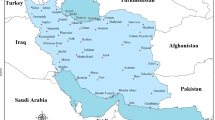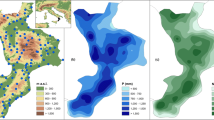Summary
¶A spatio-temporal analysis of the dry spells that occur in the Greek area is carried out for an extended period of 40 years (1958–1997). The dry spells can be defined as a number of consecutive days with no rain. The number of days defines the length of the dry spells. The longest spells are identified in central (Cyclades) and the south-east Aegean Sea whereas dry spells with the minimum length are shown over the north-west of the Greek area that reflects the significance of the latitude and the topography. Negative Binomial Distribution and Markov Chains of second order have been used to fit the duration of the dry spells of different lengths. The study of the seasonal and annual distribution of the frequency of occurrence of dry spells revealed that the dry spells in Greece depict a seasonal character, while medium and long sequences are associated with the duration and hazards of drought.
Similar content being viewed by others
Author information
Authors and Affiliations
Additional information
Received February 20, 2002; revised September 5, 2002; accepted October 6, 2002
Rights and permissions
About this article
Cite this article
Anagnostopoulou, C., Maheras, P., Karacostas, T. et al. Spatial and temporal analysis of dry spells in Greece. Theor. Appl. Climatol. 74, 77–91 (2003). https://doi.org/10.1007/s00704-002-0713-5
Issue Date:
DOI: https://doi.org/10.1007/s00704-002-0713-5




